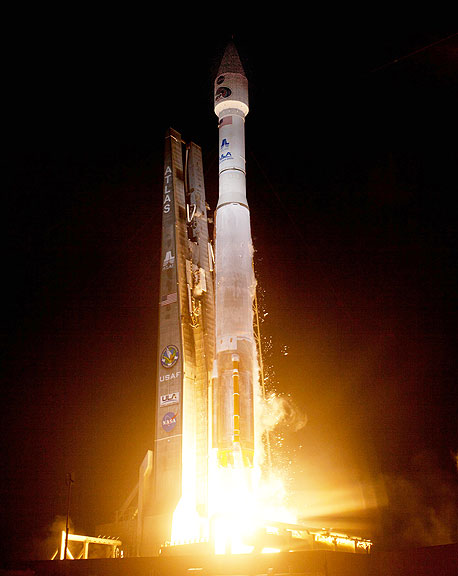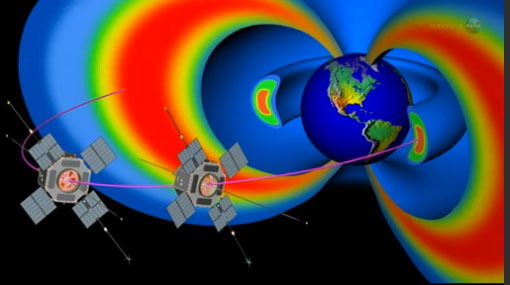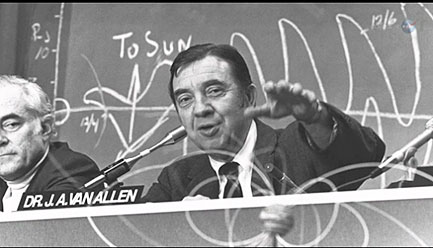
Cape Canaveral Air Force Station, Fla. (Aug. 30, 2012) – A United Launch Alliance Atlas V rocket blasts off from Space Launch Complex-41 at 4:05 a.m. EDT with NASA’s twin Radiation Belt Storm Probes mission. This is ULA’s 7th launch of the year, the 32nd Atlas V launch and marked the 63rd launch since ULA was formed in December 2006. RBSP will explore space weather changes in Earth's space environment caused by the sun that can disable satellites, create power grid failures and disrupt GPS service. Photo by Pat Corkery, United Launch Alliance
[SatNews]..."The excitement of seeing the spacecraft in orbit and beginning to perform science measurements is like no other thrill..."
Most spacecraft try to avoid the Van Allen Belts, two doughnut-shaped regions around Earth filled with "killer electrons." This morning a United Launch Alliance Atlas V rocket carrying the Radiation Belt Storm Probes (RBSP), the first twin-spacecraft for NASA, lifted off from Space Launch Complex-41 at Cape Canaveral at 4:05 a.m. EDT today.
NASA’s two heavily-shielded spacecraft were launched directly into the belts. The Radiation Belt Storm Probes are on a two-year mission to study the Van Allen Belts and to unravel the mystery of their unpredictability. This is ULA’s 7th launch of the year, the 32nd Atlas V launch and marked the 63rd launch since ULA was formed in December 2006.
"The ULA team and our many mission partners are very proud of our role in delivering the twin RBPS spacecraft to orbit to conduct research about our space weather and gather important data that impacts our everyday life on Earth,” said Jim Sponnick, ULA vice president, Mission Operations. “The successful launch of this mission is a tribute to the partnerships with the highly skilled and professional teams from NASA’s Launch Services Program and The Johns Hopkins University Applied Physics Laboratory.”
This mission was launched aboard an Atlas V EELV 401 configuration vehicle, which includes a 4-meter diameter payload fairing. The Atlas booster for this mission was powered by the RD AMROSS RD-180 engine and the Centaur upper stage was powered by a single Pratt & Whitney Rocketdyne RL10A-4 engine.
RBSP will explore space weather—changes in Earth's space environment caused by the sun—that can disable satellites, create power grid failures, and disrupt GPS service. The mission also will allow researchers to understand fundamental radiation and particle acceleration processes throughout the universe.
"Scientists will learn in unprecedented detail how the radiation belts are populated with charged particles, what causes them to change and how these processes affect the upper reaches of the atmosphere around Earth," said John Grunsfeld, associate administrator for NASA's Science Mission Directorate at Headquarters in Washington. "The information collected from these probes will benefit the public by allowing us to better protect our satellites and understand how space weather affects communications and technology on Earth."

Courtesy of NASA
The two satellites, each weighing just less than 1,500 pounds, comprise the first dual-spacecraft mission specifically created to investigate this hazardous regions of near-Earth space, known as the radiation belts.
These two belts, named for their discoverer, James Van Allen, encircle the planet and are filled with highly charged particles. The belts are affected by solar storms and coronal mass ejections and sometimes swell dramatically. When this occurs, they can pose dangers to communications, GPS satellites and human spaceflight.
"We have never before sent such comprehensive and high-quality instruments to study high radiation regions of space," said Barry Mauk, RBSP project scientist at the Johns Hopkins University's Applied Physics Laboratory (APL) in Laurel, Maryland. "RBSP was crafted to help us learn more about, and ultimately predict, the response of the radiation belts to solar inputs."

Dr. J.A. Van Allen
The hardy RBSP satellites will spend the next 2 years looping through every part of both Van Allen belts. By having two spacecraft in different regions of the belts at the same time, scientists finally will be able to gather data from within the belts themselves, learning how they change over space and time. Designers fortified RBSP with special protective plating and rugged electronics to operate and survive within this punishing region of space that other spacecraft avoid. In addition, a space weather broadcast will transmit selected data from those instruments around the clock, giving researchers a check on current conditions near Earth.
"The excitement of seeing the spacecraft in orbit and beginning to perform science measurements is like no other thrill," said Richard Fitzgerald, RBSP project manager at APL. "The entire RBSP team, from across every organization, worked together to produce an amazing pair of spacecraft."
During the next 60 days, operators will power up all flight systems and science instruments and deploy long antenna booms, two of which are more than 54 yards long. Data about the particles that swirl through the belts, and the fields and waves that transport them, will be gathered by five instrument suites designed and operated by teams at the New Jersey Institute of Technology in Newark; the University of Iowa in Iowa City; University of Minnesota in Minneapolis; and the University of New Hampshire in Durham; and the National Reconnaissance Office in Chantilly, Va. The data will be analyzed by scientists across the nation almost immediately.
LWS is managed by the agency's Goddard Space Flight Center in Greenbelt, Maryland. APL built the RBSP spacecraft and will manage the mission for NASA. NASA's Launch Services Program at Kennedy is responsible for launch management. United Launch Alliance provided the Atlas V launch service.
Since the inaugural flights in 2002, Atlas V and Delta IV launch vehicles have delivered more than 50 critical capabilities including vital national security missions for the U.S. Air Force and National Reconnaissance Office, science and exploration payloads for NASA and commercial imaging and communications satellites. “Just last week the ULA team celebrated the 10th anniversary of the first Atlas V launch,” said Sponnick. “In the last decade, the Atlas V and Delta IV EELV systems have demonstrated outstanding success in launching our customer’s missions.”
ULA’s Atlas V and Delta IV launch vehicles provide a 33 percent cost savings over heritage launch systems and are the most commercially developed vehicles flying today with Lockheed Martin and The Boeing Company having funded 80 percent of their development.
Developed by the United States Air Force to provide assured access to space for Department of Defense and other government payloads, the commercially developed EELV Program supports the full range of government mission requirements, while delivering on schedule and providing significant cost savings over the heritage launch systems.
ULA's next launch is the Atlas V NROL-36 mission for the National Reconnaissance Office planned for September 13 from Space Launch Complex-3 at Vandenberg Air Force Base, California.
ULA program management, engineering, test, and mission support functions are headquartered in Denver, Colorado. Manufacturing, assembly and integration operations are located at Decatur, Alabama, and Harlingen, Texas. Launch operations are located at Cape Canaveral AFS, Florida, and Vandenberg AFB, California.
Since 1998, NASA’s Launch Services Program has been based at Kennedy Space Center, Florida, and provides oversight as the designs of the rocket and mission are integrated with each other.

